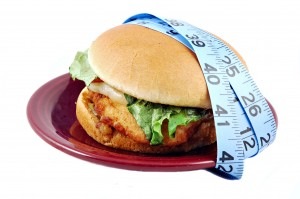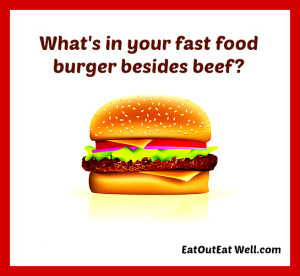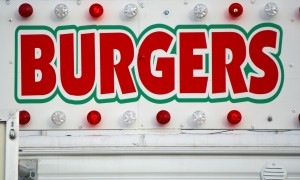
[Source: Today I found out]
hamburger
What’s In Your Big Mac Or Fast Food Burger Besides Beef?
Have you had a Big Mac in different parts of the country or even in different parts of the world? It tastes pretty much the same – which, in some ways, is rather comforting when you might be far from home.
Fast food is cheap, quick, reproducible in any outlet, often tasty, and consistent. To be all of those things makes it pretty difficult to use locally sourced and fresh ingredients.
Fast food restaurants might be trying to make their menus healthier by adding veggies and fruit, but the bottom line is that much of their food is processed and preserved – and that doesn’t happen without chemicals.
An occasional trip to Mickey D’s isn’t a disaster and the burger content is beef (although who knows the source of the cows, what parts of the cow are used, and what they’ve been fed). But what about the bun, the sauce, and the cheese that accompany the burger? How does the bun stay soft and how does the “special sauce” always taste the same?
Take a look at the ingredients in a Big Mac, a burger, and cheeseburger from McDonald’s (all info is from McDonald’s own site). Although McDonald’s is used as an example, almost all of the fast food chains use additives and preservatives in their food. One of the biggest shockers is the bun – ask a home baker or a bakery how many ingredients they put in their buns – then look at these. Then check out the sauce.
Then decide how frequently you want to indulge.
Big Mac:
Components: 100% BEEF PATTY, BIG MAC BUN, PASTEURIZED PROCESS AMERICAN CHEESE, BIG MAC SAUCE, SHREDDED LETTUCE, PICKLE SLICES, ONIONS
Ingredients: 100% Pure USDA Inspected Beef; No Fillers, No Extenders. Prepared with Grill Seasoning (Salt, Black Pepper).
Ingredients: Enriched Flour (Bleached Wheat Flour, Malted Barley Flour, Niacin, Reduced Iron, Thiamin Mononitrate, Riboflavin, Folic Acid), Water, High Fructose Corn Syrup and/or Sugar, Yeast, Soybean Oil and/or Canola Oil, Contains 2% or Less: Salt, Wheat Gluten, Calcium Sulfate, Calcium Carbonate, Ammonium Sulfate, Ammonium Chloride, Dough Conditioners (May Contain One or More of: Sodium Stearoyl Lactylate, DATEM, Ascorbic Acid, Azodicarbonamide, Mono and Diglycerides, Ethoxylated Monoglycerides, Monocalcium Phosphate, Enzymes, Guar Gum, Calcium Peroxide), Sorbic Acid, Calcium Propionate and/or Sodium Propionate (Preservatives), Soy Lecithin, Sesame Seed.
Ingredients: Soybean Oil, Pickle Relish (Diced Pickles, High Fructose Corn Syrup, Sugar, Vinegar, Corn Syrup, Salt, Calcium Chloride, Xanthan Gum, Potassium Sorbate [Preservative], Spice Extractives, Polysorbate 80), Distilled Vinegar, Water, Egg Yolks, High Fructose Corn Syrup, Onion Powder, Mustard Seed, Salt, Spices, Propylene Glycol Alginate, Sodium Benzoate (Preservative), Mustard Bran, Sugar, Garlic Powder, Vegetable Protein (Hydrolyzed Corn, Soy and Wheat), Caramel Color, Extractives of Paprika, Soy Lecithin, Turmeric (Color), Calcium Disodium EDTA (Protect Flavor).
Crinkle Cut Pickles: Ingredients: Cucumbers, Water, Distilled Vinegar, Salt, Calcium Chloride, Sodium Benzoate (Preservative), Natural Flavors (Plant Source), Polysorbate 80, Extractives of Turmeric (Color).
Pasteurized Process American Cheese: Ingredients: Milk, Cream, Water, Cheese Culture, Sodium Citrate, Contains 2% or Less of: Salt, Citric Acid, Sodium Phosphate, Sorbic Acid (Preservative), Lactic Acid, Acetic Acid, Enzymes, Sodium Pyrophosphate, Natural Flavor (Dairy Source), Color Added, Soy Lecithin (Added for Slice Separation).
Hamburger:
Components: 100% BEEF PATTY, REGULAR BUN, KETCHUP, MUSTARD, PICKLE SLICES, ONIONS
Cheeseburger:
Components: 100% BEEF PATTY, REGULAR BUN, PASTEURIZED PROCESS AMERICAN CHEESE, KETCHUP, MUSTARD, PICKLE SLICES, ONIONS
100% Beef Patty: Ingredients: 100% Pure USDA Inspected Beef; No Fillers, No Extenders. Prepared with Grill Seasoning (Salt, Black Pepper).
Regular Bun: Ingredients: Enriched Flour (Bleached Wheat Flour, Malted Barley Flour, Niacin, Reduced Iron, Thiamin Mononitrate, Riboflavin, Folic Acid), Water, High Fructose Corn Syrup and/or Sugar, Yeast, Soybean Oil and/or Canola Oil, Contains 2% or Less: Salt, Wheat Gluten, Calcium Sulfate, Calcium Carbonate, Ammonium Sulfate, Ammonium Chloride, Dough Conditioners (May Contain One or More of: Sodium Stearoyl Lactylate, DATEM, Ascorbic Acid, Azodicarbonamide, Mono and Diglycerides, Ethoxylated Monoglycerides, Monocalcium Phosphate, Enzymes, Guar Gum, Calcium Peroxide), Sorbic Acid, Calcium Propionate and/or Sodium Propionate (Preservatives), Soy Lecithin.
Pasteurized Process American Cheese:
Ingredients: Milk, Cream, Water, Cheese Culture, Sodium Citrate, Contains 2% or Less of: Salt, Citric Acid, Sodium Phosphate, Sorbic Acid (Preservative), Lactic Acid, Acetic Acid, Enzymes, Sodium Pyrophosphate, Natural Flavor (Dairy Source), Color Added, Soy Lecithin (Added for Slice Separation).
Nutrition:
Big Mac, 7.6 oz: 550 calories, 29g fat, 10g saturated fat, 1g trans fat, 970mg sodium, 46g carbs, 25g protein
Hamburger, 3.5 oz: 250 calories, 9g fat, 3.5g saturated fat, 0.5 trans fat, 480mg sodium, 31g carbs, 12g proteinS
Cheeseburger, 4 oz.: 300 calories, 12g fat, 6g saturated fat, 0.5g trans fat, 680mg sodium, 33g carbs, 15g protein
A Tasty Way To Lighten Up Your Burger
In my neck of the woods, barbecue season is right around the corner.
I happen to love hamburgers, but, needless to say, I don’t love the calories and saturated fat in most of them.
Some Hamburger Stats
Most (not all) hamburgers are made with either ground round or ground chuck and are usually six or more ounces.
A broiled burger made with ground round (85% lean meat) has 70 calories in each ounce with 4 grams of fat (2 grams saturated fat).
A broiled burger made with ground chuck (80% lean meat) has 76 calories in each ounce with 5 grams of fat (2 grams saturated).
How about substituting chopped vegetables for some of the meat? Onions, garlic, peppers, and mushrooms are some possibilities. An ounce of onions is 11 calories with no fat; an ounce of white mushrooms has 6 calories and no fat.
Switching out an ounce or two of meat for veggies can save you 60 to 150 or so calories and 4 to 10 grams of fat and add a whole bunch of flavor.
Try it – you might like it!
Burgers (Yes) Or Hotdogs (No) on Your Grill?
Burgers – Is That A Yes?
Sort of. A study just published in the journal Circulation analyzed the effects of eating red unprocessed meat (100g a day of unprocessed beef, pork, or lamb) compared to processed meat products (50g of meat preserved by smoking, curing, salting, or with added chemical preservatives such as sausages, bacon, and salami).
Researchers at the Harvard School of Public health analyzed data from studies that looked at red and processed meat consumption and possible links to heart disease and diabetes. The studies included over 1.2 million people who were followed from 4 to 18 years. The conclusion: red unprocessed meat isn’t associated with an increased risk of diabetes or coronary heart disease. Eating the equivalent of one hot dog or two slices of deli meat a day (50 g of processed meat) is associated with a 42% higher risk of coronary heart disease and a 19% increased risk of diabetes.
Suspected Demons: Salt And Preservatives
We’re used to the US guidelines that recommend eating less red and unprocessed meat — but these guidelines are based on the projected effects of the saturated fat and cholesterol in the meat. Red meat and processed meat contain a similar amount of both of these, but processed meat has about four times the amount of sodium and 50% more preservatives (like nitrates) than unprocessed red meat.
Conclusion: this study (a systematic review of nearly 1,600 studies from around the world that looked for links between processed and unprocessed red meat and the risk of heart disease and diabetes) suggests that salt and other preservatives might explain the higher risk associated with processed meat.
What Kind Of Meat Are They Talking About?
This study defined processed meat as any meat preserved by smoking, curing, salting, or with added chemical preservatives. This includes bacon, salami, sausages, hot dogs, and processed deli and lunch meat. The unprocessed red meat included beef, lamb, and pork, but not poultry. On average, a 1.8 oz (50 g) daily serving of processed meat (half the weight of the unprocessed meat in the study), the equivalent of one to two slices of deli meat or one hot dog, was associated with a 42% higher risk of heart disease and a 19% higher risk of diabetes and they found no higher heart or diabetes risk in people who ate only unprocessed red meat.
The average nutrients in unprocessed red and processed meats in the United States contain similar average amounts of saturated fat and cholesterol. But processed meats have, on average, four times more sodium and 50% more nitrate preservatives.
Is This A Greenlight To Chow Down On Red Meat?
Not really. Eating unprocessed beef, pork, or lamb appears not to increase the risk for heart disease and diabetes — but there is no reduced risk either. There’s also a suspected association between processed and unprocessed meats and a higher risk of some cancers (especially colorectal) so it will be important to evaluate unprocessed vs. processed meat and their effects on various cancers.
Although cause and effect can’t be proven by this long-term observational study, the results do suggest that the salt and preservatives in processed meat are culprits.
SocialDieter Tip:
You’ve heard this many times: emphasize food that is protective: fruit, vegetables, whole grains, fish, and nuts. Minimize or avoid processed meats that are high in sodium, additives, and fat. This is not a free pass to eat red meat with abandon but it seems that having unprocessed red meat once or twice a week is a lot better than having processed meat — like bacon, hot dogs, processed ham, bologna, salami — every day.
As one of the lead authors, Renata Micha, of the study says, to lower your risk of heart attacks and diabetes think about the type of meat you’re eating and “processed meats such as bacon, salami, sausages, hot dogs and processed deli meats may be the most important to avoid.”
Double Down: KFC Not Blackjack
KFC’s One-Of-A-Kind Bunless Sandwich
 D-Day: April 12th, the premier day for KFC’s Double Down one-of-a-kind sandwich. What is it? A bunless sandwich made of two boneless white meat chicken filets stacked around two pieces of bacon, two melted slices of Monterey Jack and pepper jack cheese, and Colonel’s Sauce (mayonnaise based). As KFC says in its promo: “this product is so meaty, there’s no room for a bun!”
D-Day: April 12th, the premier day for KFC’s Double Down one-of-a-kind sandwich. What is it? A bunless sandwich made of two boneless white meat chicken filets stacked around two pieces of bacon, two melted slices of Monterey Jack and pepper jack cheese, and Colonel’s Sauce (mayonnaise based). As KFC says in its promo: “this product is so meaty, there’s no room for a bun!”
Double Down, Two Ways
There are two versions of the Double Down: Original Recipe® or Grilled. According to KFC’s nutritional information:
| Sandwich | Calories | Fat (g) | Sodium (mg) | ||
| KFC Original Recipe® Double Down | 540 | 32 | 1380 | ||
| KFC Grilled Double Down | 460 | 23 | 1430 | ||
Is This Accurate Nutritional Information?
Aside from raising the hair on the back of the necks of health conscious eaters, the accuracy of the caloric listed count is being disputed. KFC says that the Double Down has 1,380 milligrams of salt and ten grams of saturated fat — already 60 per cent and 50 per cent, respectively, of the U.S. government’s recommended daily allowance. An analysis done by the Vancouver Sun estimates that the sandwich logs in at 1,228 calories and more than an entire day’s worth of the recommended allowance for fat, cholesterol, sodium, and protein. It is, what Kelly Brownell, director at Yale University’s Rudd Center For Food Policy And Obesity, calls a salt bomb. Men’s Health Food and Nutrition editor and co-author of “Eat This, Not That: Best and Worst Foods in America, says that “independent labs are estimating that it has around 1,200 calories and over 50 fat grams, based on what’s in the other KFC sandwiches.”
What Does This Nutritional Gamble Cost?
The Double Down costs $5 or $6.99 as a meal deal with fries and a soda. In a marketing move — maybe to show community commitment, KFC says that all the buns that would have been used if Double Down was not bunless will be donated to help feed America’s homeless. It is interesting that KFC, previously called Kentucky Fried Chicken, trying for a healthier image, changed their official name to KFC, taking out the prominent “fried” and offering grilled choices. What, then, is this fatty and salty menu item?
SocialDieter Tip:
Double down is high in fat, a good deal of it saturated, and a pillar of salt. It may also be a caloric nightmare depending on which analysis is accurate. It certainly is a cardiologist’s nightmare. Who knows what additives there are in the preformed chicken filets, the processed cheese, bacon, and sauce? There are other healthier options on the menu at KFC:
Grillled chicken: 190 cal, 6g fat, 1.5g sat fat, 550mg sodium
Tender Roast Sandwich (no sauce): 300 cal, 4g fat, 1.5g sat fat, 660mg sodium
Tender Roast (with sauce): 410 cal, 15g fat, 3g sat fat, 790mg sodium
Grilled Chicken Ceasar Salad (without dressing and croutons): 200 cal, 6g fat, 3g sat fat, 570mg sodium
KFC Creamy Parmesan Caesar dressing (1 pkg): 260 cal, 26g fat, 5g sat fat, 540mg sodium
Parmesan Garlic Croutons (1 pouch): 70 cal, 3g fat, 0g sat fat, 140mg sodium


